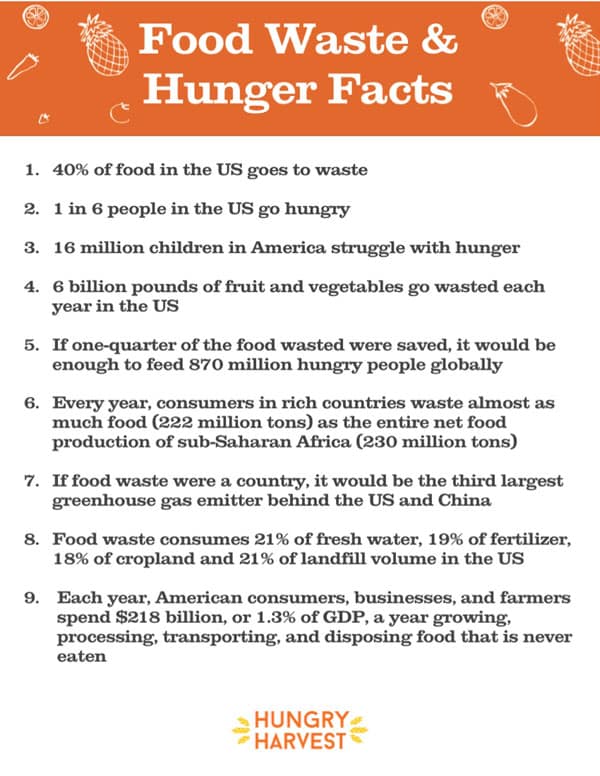Food Recovery
Feeding Families Through Food Recovery
In the US alone, tons of produce goes to waste each month because it’s not picture-perfect enough for the marketplace, or because markets have over-ordered. This concurrence of waste and abundance collides with the painful reality of hunger in America. What’s worse, an estimated 20 to 40 percent of produce is wasted while one in six people are hungry or food insecure, millions of them children.
It’s no secret that hunger is a huge problem in this land of plenty, but what’s less known is that un-composted produce dumped in landfills releases methane, a greenhouse gas many times more potent than carbon dioxide emissions.
Hungry Harvest is a young organization that works to mitigate these issues, built around the idea of recovered produce. Sometimes affectionately called “ugly produce,” a good example of unsellable, but perfectly edible produce is the almost-famous “ugly carrot.” A great introduction to the repercussions of wasting such valuable veggies is explored in “Meet the Ugly Carrot.”
Evan Lutz, Ben Simon and John Zamora were still students at the University of Maryland when they founded Hungry Harvest in 2013. The enterprising trio was introduced to JFE® readers in “Harvesting Solutions to Food Waste.” Since then, Hungry Harvest has grown and expanded on the premise that “Nutritious food is a right, not a privilege.”
The idea, in a nutshell, is this: Hungry Harvest purchases imperfect produce from local farmers who might otherwise not be able to sell it. “Surplus and imperfect are sourced from growers to ensure every harvested piece of food reaches a hungry person and gives our growers a higher value for their total yield,” explains Stacy Carroll, director of partnerships. Then, shares of ever-so-slightly flawed produce (and other edibles) are distributed to paying subscribers, much like the CSA (community-supported agriculture) model. Finally, the earnings from paid subscribers fund the donation of recovered produce to those in need. These paid proceeds from each share allow Hungry Harvest to donate two pounds of produce to families in need. “We subsidize food through our food access model Produce in a SNAP,” Carroll explains.
Subscribers who receive a weekly share of seasonal produce (in a harvest box) find that the cost is quite reasonable, usually less than what the same would cost in a supermarket. Here’s more about how it works.
Any produce that’s unusable is composted, making this endeavor as waste-free as it can be. According to Hungry Harvest, US farmers spend $218 billion a year to grow food that’s not eaten, so the Hungry Harvest system truly becomes a win for all involved.
Consumers seem to be more open to “ugly produce” than in the past. Witness the embrace of heirloom tomatoes—hardly beauties to the eye, with their scarring, deep grooves and uneven tones. But our palates have learned that these are among the tastiest tomatoes on the planet. And most of us don’t care about a few spots on our apples if they’re fresh, juicy and pesticide-free.
For Hungry Harvest, partnering with other organizations and companies is part of the recipe for success. One of them is the Jewish Relief Agency, whose strength lies in a network of thousands of volunteers. Though originally founded to serve struggling Jewish families, the agency now assists more than 3,000 low-income households in the greater Philadelphia area.
Every Sunday, up to 1,000 JRA volunteers of all ages and backgrounds convene in their northeast Philly warehouse to pack up non-perishable kosher food as well as produce—including donations from Hungry Harvest. Then, cars are loaded up cars food is delivered right to the homes of those in need.
Hungry Harvest currently operates in Maryland, Washington, DC, Northern Virginia, Philadelphia, southern New Jersey, and Miami, with national presence for wholesale.
The immensely practical and humane ideas behind Hungry Harvest are needed more than ever. If this brilliant concept begins to spread nationwide, it can help revolutionize access to fresh food for everyone, no matter their circumstances and where they live.
To learn more, visit Hungry Harvest’s website.


